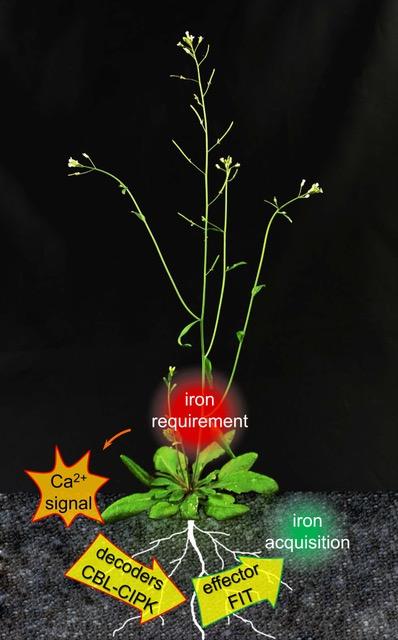Researchers have discovered a new switch that plants use to control their responses to iron deficiency

Credit: HHU / Tzvetina Brumbarova
Iron is an essential nutrient for plants, animals and also for humans. It is needed for a diverse range of metabolic processes, for example for photosynthesis and for respiration. If a person is lacking iron, this leads to a major negative impact on health. Millions of people around the globe suffer from iron deficiency each year. Iron enters the human food chain through plants, either directly or indirectly. Although there are large quantities of iron in the soil in principle, plants may become iron-deficient because of the specific composition of the soil. Additionally, a plant’s iron requirements vary throughout its development depending on external circumstances.
Because plants are sessile, they cannot escape their respective situation. Consequently, they have evolved strategies to recognise changing environmental conditions at an early stage and to adapt to these changes. Particularly in view of climate change, understanding the processes that plants use to adjust to variations in food supply when environmental factors become unpredictable is also of major importance to the agricultural sector and its collaborating research partners in their endeavours to breed new varieties of high-yield crop plants.
Iron regulation is an important model system in plant biology for understanding how cellular regulation processes impact on each other and the related signalling paths. Researchers at HHU under the leadership of Prof. Petra Bauer and her associate Dr. Tzvetina Brumbarova and at WWU under the leadership of Prof. Jörg Kudla and Prof. Uwe Karst have examined the special mechanisms and dynamics of a protein named “FIT” in iron uptake and have discovered cellular information processes that impact on FIT.
The FIT protein was discovered by Prof. Bauer’s working group, and its regulation mechanisms are being examined at the Institute of Botany at HHU. FIT can be present in an active and an inactive state. In the model plant Arabidopsis thaliana, it plays a key role in regulating iron uptake. How the plant decides how much iron to absorb and how to transmit this information to the FIT regulator is, however, the subject of current research at HHU. The FIT regulation mechanism described in Düsseldorf combines different signals used by the plant to respond to environmental and stress conditions.
The Münster-based plant biologists working with Prof. Kudla from the Institute of Plant Biology and Biotechnology are specialised in understanding what is referred to as ‘cellular signal transduction’, in particular calcium signal transduction. This involves a signal transmission whereby the plant converts and passes on information about the environment and triggers stress responses for example – or, as demonstrated in the present case, a better response to iron deficiency. To this end, the team at the WWU Institute of Inorganic and Analytical Chemistry headed up by Prof. Karst analysed the iron concentration in the plants.
So far, the precise link between iron and calcium was unclear. Now the research teams at HHU and WWU have found that iron deficiency triggers calcium signals, having a significant influence on the FIT regulation mechanism. In the joint study published in Developmental Cell, the research teams describe how the enzyme CIPK11 linked to calcium detection can interact with and mark the FIT protein. Ultimately the plant can use this FIT activation to control iron uptake in its roots and iron storage in its seeds.
“We were able to track down molecular and cellular mechanisms that link FIT to the decoding of calcium signals. This in turn is important when the plant has to control iron uptake dependent on external factors”, explain Dr. Brumbarova and Prof. Bauer. Prof. Kudla adds: “Our discovery has implications for biological and also medical questions relating to nutrients, development processes and stress behaviours.”
###
Media Contact
Dr. Kathrin Kottke
[email protected]
49-251-832-1899
Original Source
https:/
Related Journal Article
http://dx.




